Seasoned and fermented to perfection, this easy Korean Kimchi is one very versatile dish. Eat it by itself or add to a myriad of meals including Korean Army Stew and Pajeon Kimchi Seafood Pancakes.
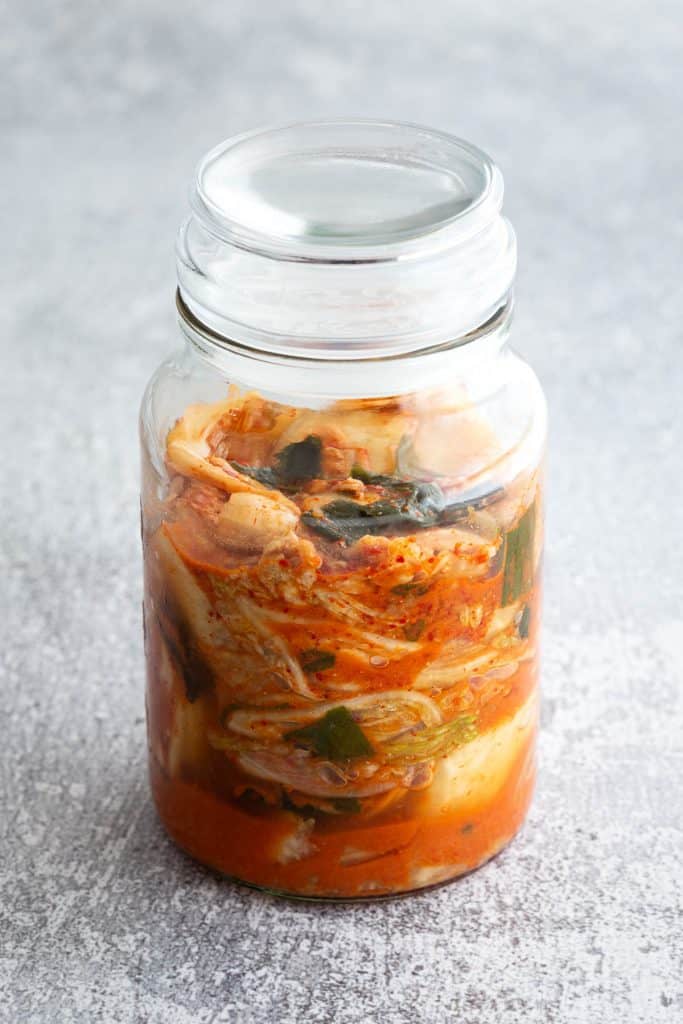
Why We Love This
Delicious Korean kimchi is so easy to make at home. Eat it the next day or wait after a week or two of fermentation for extra flavour. It’s perfect to have as a side dish to your favourite Korean meal or spice up a stir fry.
Love homemade pickling and fermenting? Try our delicious Korean pickled onions, Japanese pickled daikon or pickled ginger to add even more flavour to your table.
Related: Korean Radish Kimchi – KKakdugi / Gochujang Jjigae Stew
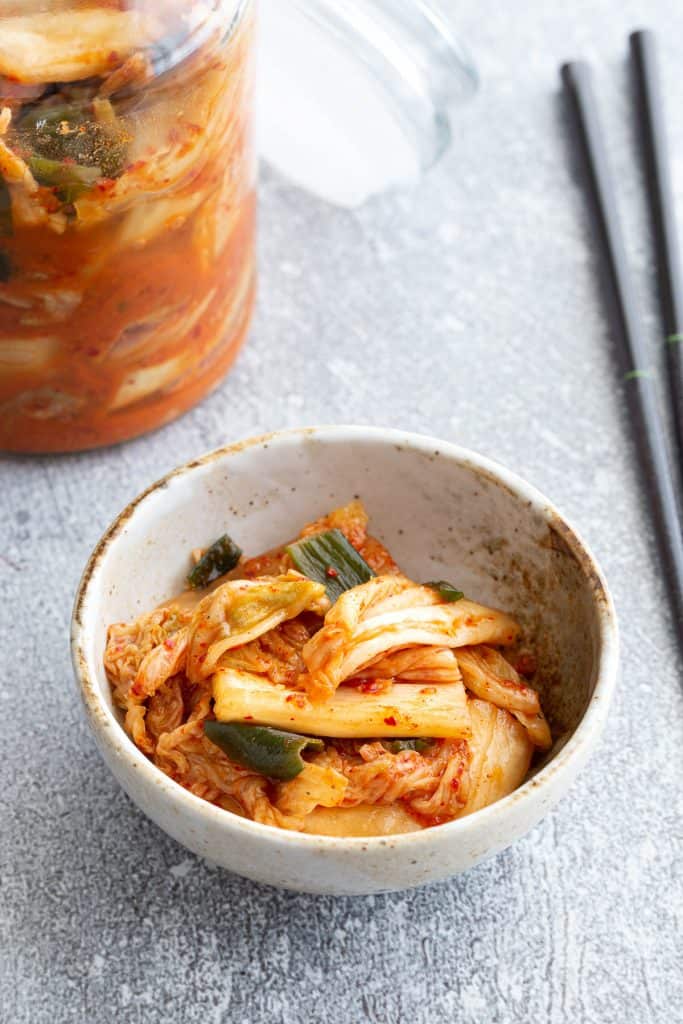
What is Kimchi?
Kimchi has to be one of the most well-known Korean foods, but did you know that there used to be around 200 different kinds? Today around 30 variations remain.
Although the flavour of fermented kimchi seems like it must contain vinegar, that’s actually not the case at all; the recipe calls for salted shrimp and fish sauce to give it a real umami kick.
Mixed with the sweetness of freshly squeezed pear juice, garlic and chilli, kimchi can be eaten shortly after preparation or left to ferment for a few weeks for added depth of flavour.
Our style of kimchi is known as mak kimchi – the shortcut version. Traditionally, the cabbage is kept whole, halved or quartered, but we love working with the smaller pieces so it’s easier to prepare and eat!
Where We Learnt This Recipe
Through our travels in Seoul, we came across the awesome F&C Korean Food & Culture Academy, who taught us this amazing recipe during a fun and informative cooking class. We also learnt to cook bulgogi and pajeon.
What You’ll Need
- Napa Cabbage – Also known as Baechu in Korean, or sometimes referred to as Chinese/ Asian cabbage or wombok. This is the traditional cabbage used for kimchi. It has the perfect texture of crunchy stems and soft leaves, and contains less water than other varieties for a better texture in Kimchi. You can substitute if necessary, but you’ll need to adjust your fermentation time to account for the difference in texture of other cabbage varieties.
- Coarse Salt (Sea Salt) – This is used to soak and soften the cabbage because it melts slower and so absorbs into the leaves more gradually. We don’t recommend using fine salt or regular table salt as this can affect the fermentation process.
- Korean Hot Pepper Flakes (Gochugaru) – These chilli flakes are milder than regular chilli flakes. The chillies are deseeded before processing, giving them the classic bright red colour. Substitute with Korean red pepper paste / gochujang in a pinch.
- Salted Shrimp – This is the key ingredient to a traditional kimchi seasoning. If you can’t track it down, you can substitute with miso paste (red in the first instance, or white), or with fish sauce. Otherwise, use soy sauce for the substitute here as well for the vegan version.
- Fish sauce (Korean style) – Substitute with soy sauce for the vegan variant.
- Pear juice – Substitute with apple juice.
- Dashi stock – Korean fish and seaweed stock is made with soaked kelp and dried pollack, but you can substitute if required with powdered seaweed stock for a vegan version. We usually use our Japanese dashi stock that we already have on hand, which is very similar.
In addition to the above, you’ll also need sugar, garlic and spring onion (green onion) for the spice paste.
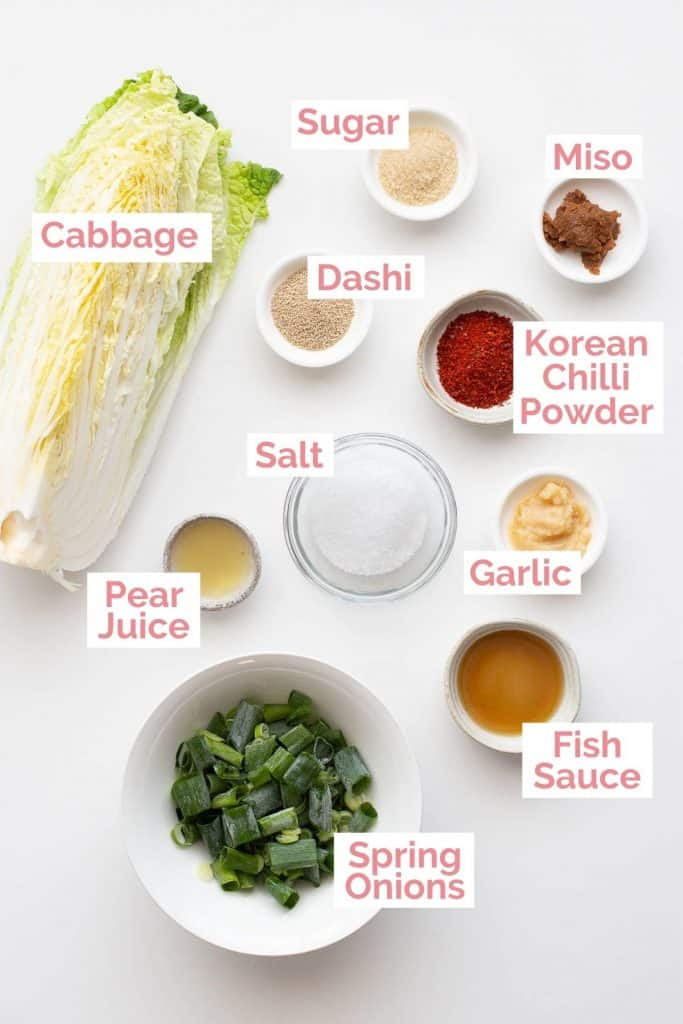
How to make Homemade Kimchi:
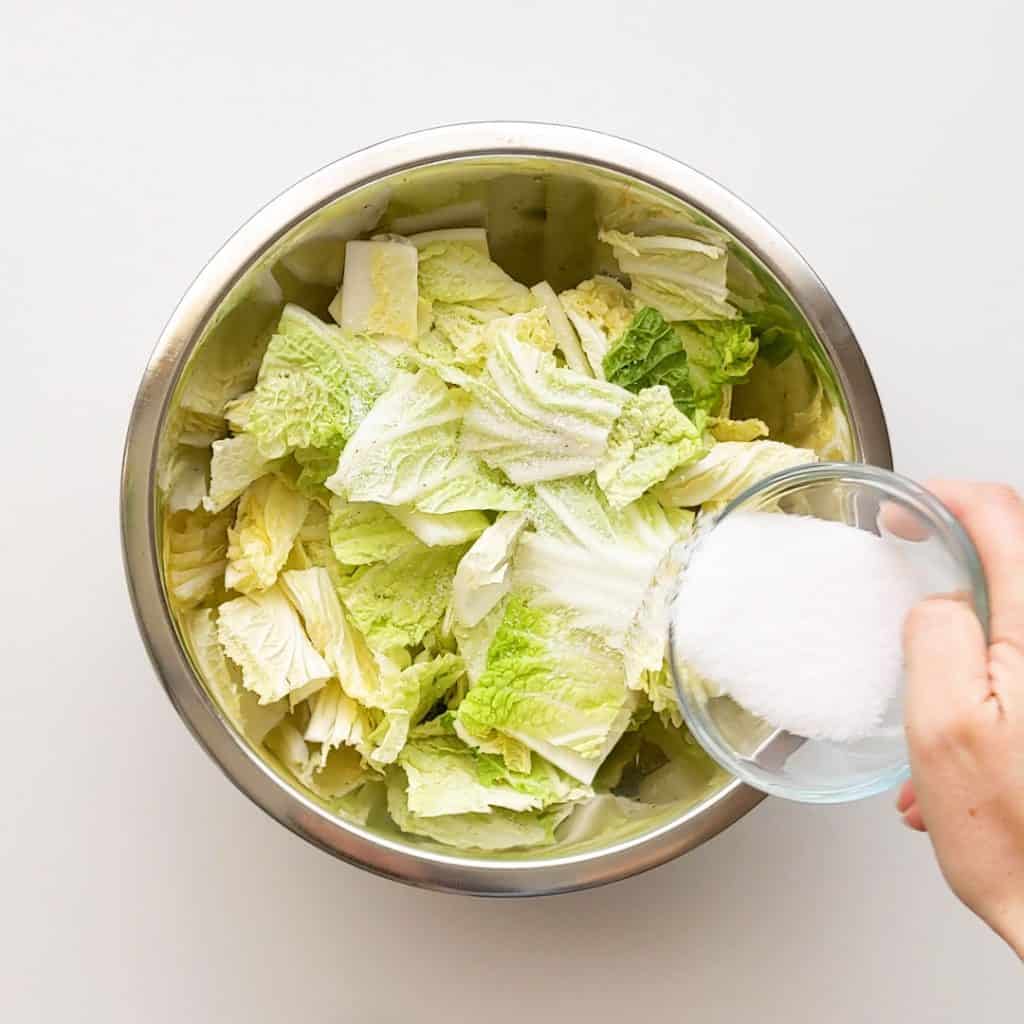
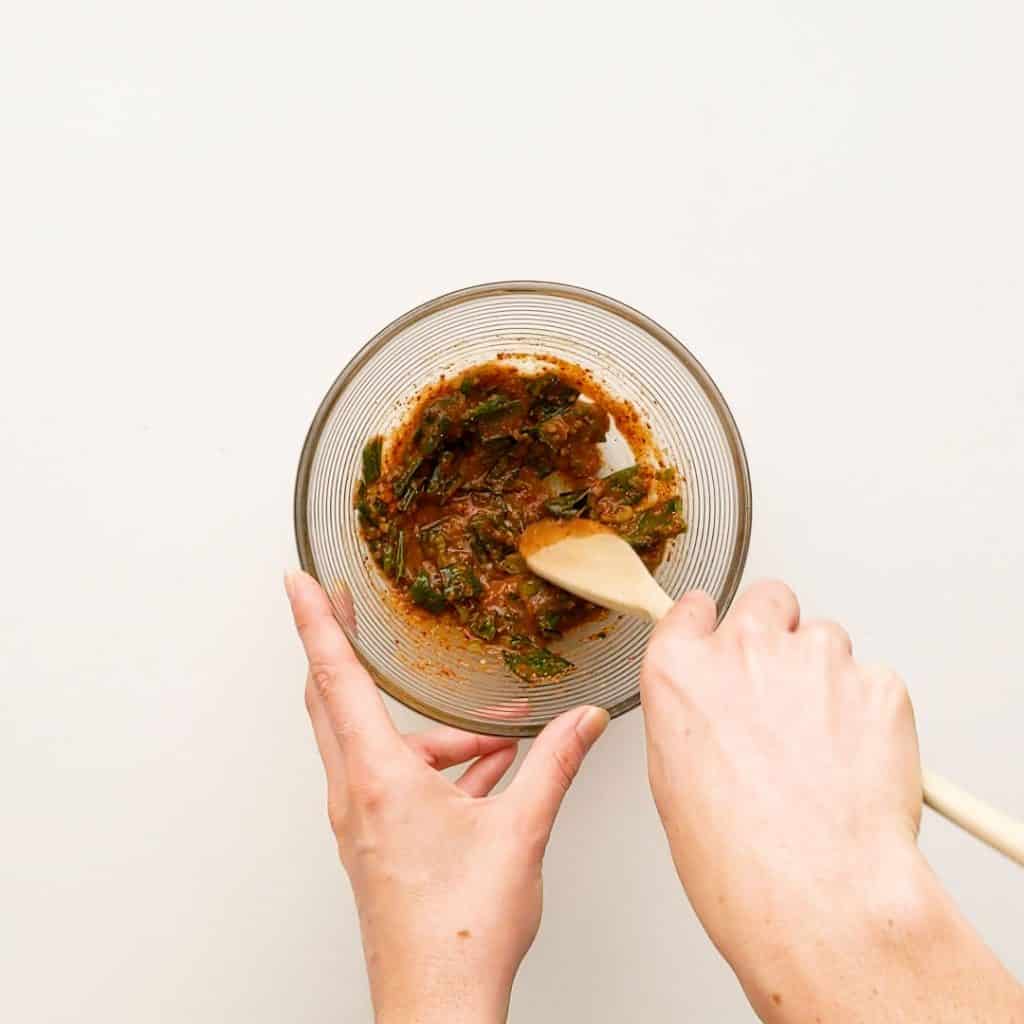
- Chop cabbage into large chunks and sprinkle with the salt. Mix it through all the leaves. Add 6 cups (1.5 quart / 1.5 litres) of cold water and mix the cabbage again. Pop a heavy plate on top, to keep the cabbage under water.
- Soak the salted cabbage in the salt water for 4 – 6 hours, turning over the cabbage pieces every 2 hours. Humidity will play a role here, so the higher the humidity in your environment the less time you’ll need to soak and vice versa. In Australia, it’s recommended to soak around 4 hours.
- While the cabbage is soaking, it’s time to mix the seasoning. In a small bowl, add the Korean chilli flakes, garlic, salted shrimp (or miso), fish sauce, sugar, pear juice (or apple), dashi stock and chopped spring onion.
- After soaking the cabbage, rinse the cabbage two or three times under fresh water to remove the salt. We find a colander works well for this step. The cabbage should now have a flexible texture.
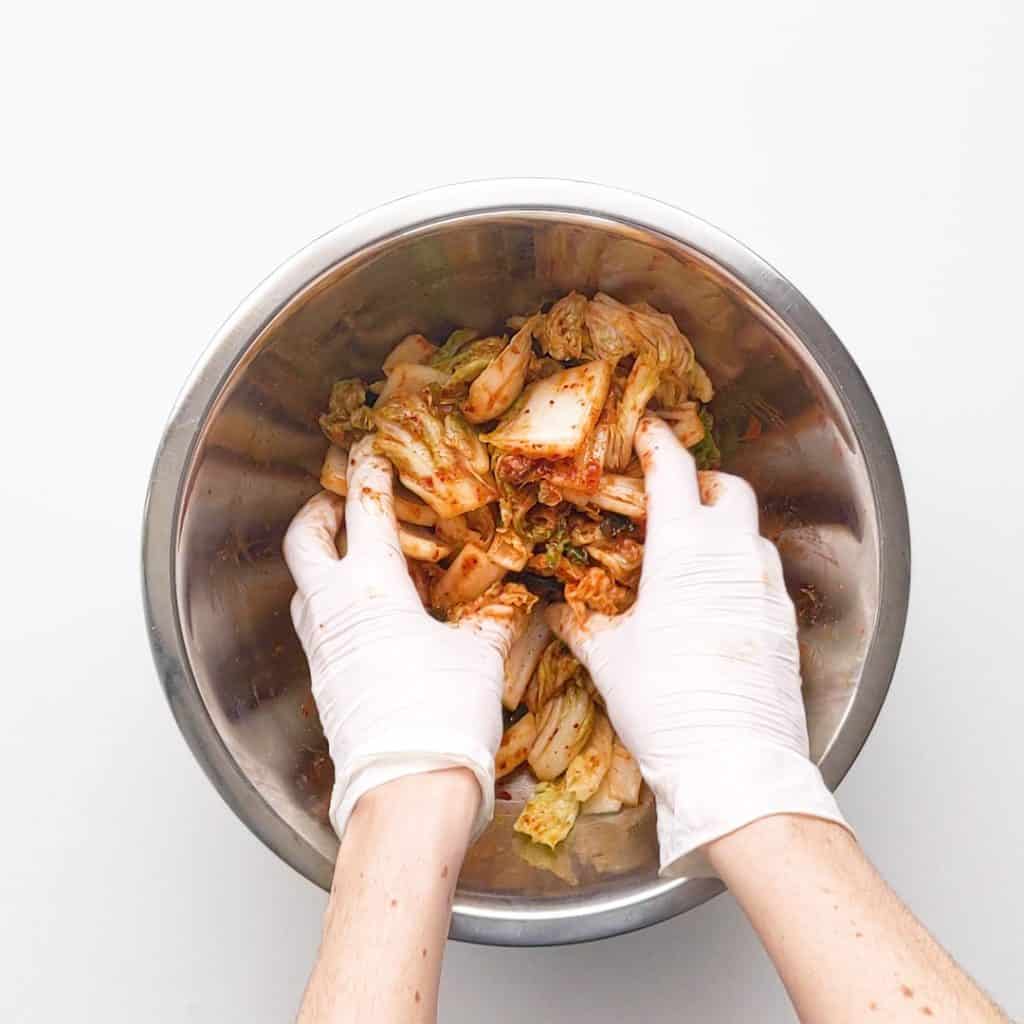
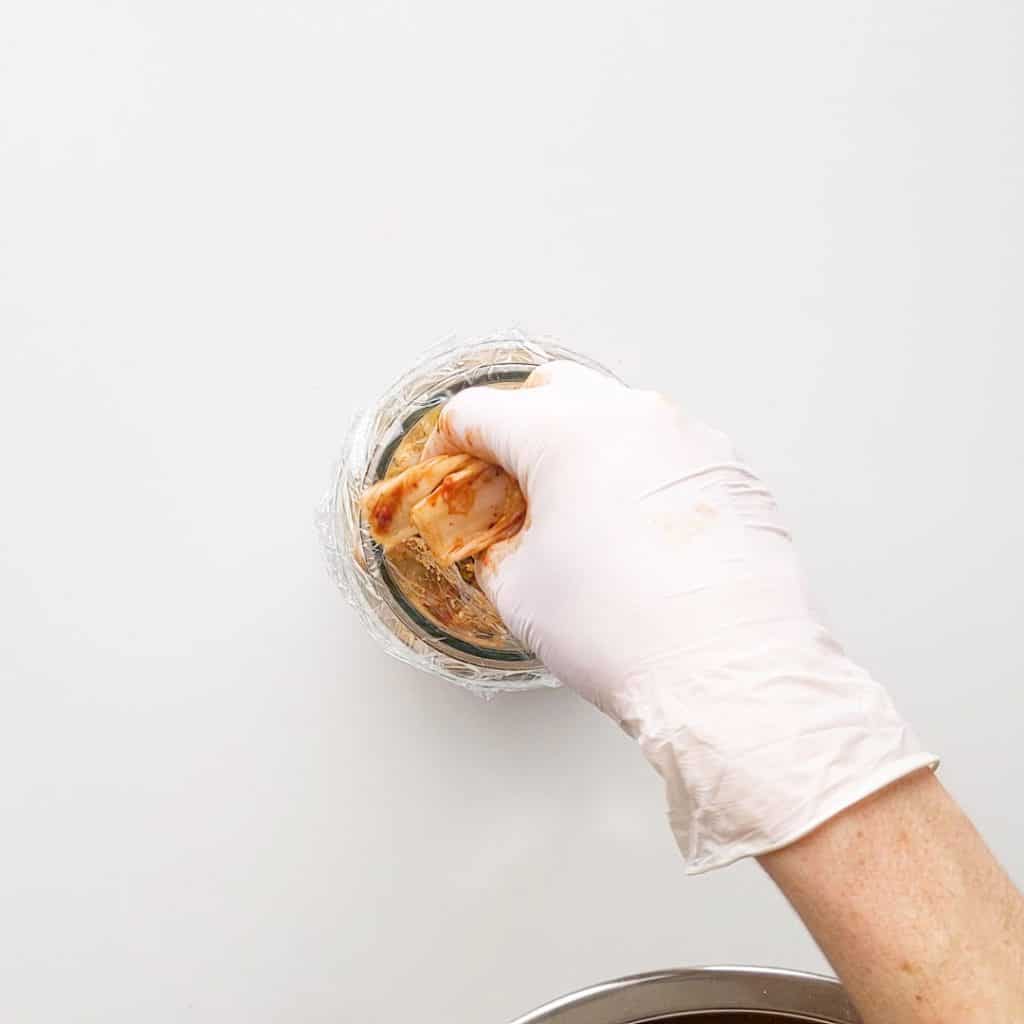
- Transfer the rinsed cabbage to a large bowl and add the kimchi seasoning. (We recommend gloves for this next step.) Using your hands, work the seasoning through the cabbage, making sure everything is very well coated. You can have a taste here and see if your kimchi needs any more chilli or salt to your preference.
- Next it’s time to store the kimchi in a large jar. We recommend lining the top of the jar with cling wrap, then poking a hole to fill it, that way the the top of the jar will stay clean. Pop in all the kimchi, then press it down firmly so it’s all compacted. This is important to get out air bubbles and help the fermentation process.
- Leave on the bench for 24 hours to kick off the fermentation, then transfer to the fridge and eat whenever you like.
What To Do With Your Fresh Homemade Kimchi:
- Add it to stir fries
- Serve as a side dish alongside braised potatoes or steamed fish parcels.
- Eat as a snack
- Add to Korean Army Stew or dakgalbi
- Make savoury kimchi and cheese waffles topped with mayo and sriracha!
- Add to sandwiches
- Put in toasties and dip in mayo
- Add in dumplings
- Pop in fried rice or noodle dishes
- Cook into savoury pancakes
Wandercook’s Tips
- Don’t Seal Tightly – Since kimchi is a fermented food, gasses can build as part of the fermentation process. It’s best not to seal the jar or container too tightly, otherwise it could potentially pop and overflow!
- Fresh vs Aged Kimchi – Fresh kimchi (anything under 2 weeks old) is great to eat alone or as a spicy side dish. Aged kimchi is much more sour and better to use as a flavour enhancer in other dishes.
FAQs
Homemade kimchi can be as spicy as you like. Traditional is quite hot and uses a lot of chilli flakes. This recipe is quite mild to start, but you can double or triple the amount of chilli flakes to suite your taste.
Kimchi will last one week out of the fridge at room temperature, as the fermentation process is sped up. However, it will last 3-6 months in the fridge. If it has any mould, smells alcoholic or ‘off’, then it should be discarded straight away.
Black spots on napa cabbage are totally fine. Known as ‘pepper spot’, it is usually found on the white part of the stem and is a cosmetic defect during growth. It will continue to get worse over time and travel to the green part of the leaves. It’s usually fine to eat, but if it looks quite severe, it may be best to discard and purchase a fresh cabbage.
No. This won’t give the same flavour or result as Korean red pepper flakes / gochugaru. If you must substitute, you can use gochujang, the fermented chilli paste.
Variations
- Add Carrots and Daikon – You can grate or julienne carrot and daikon to add to your kimchi for an extra flavour hit.
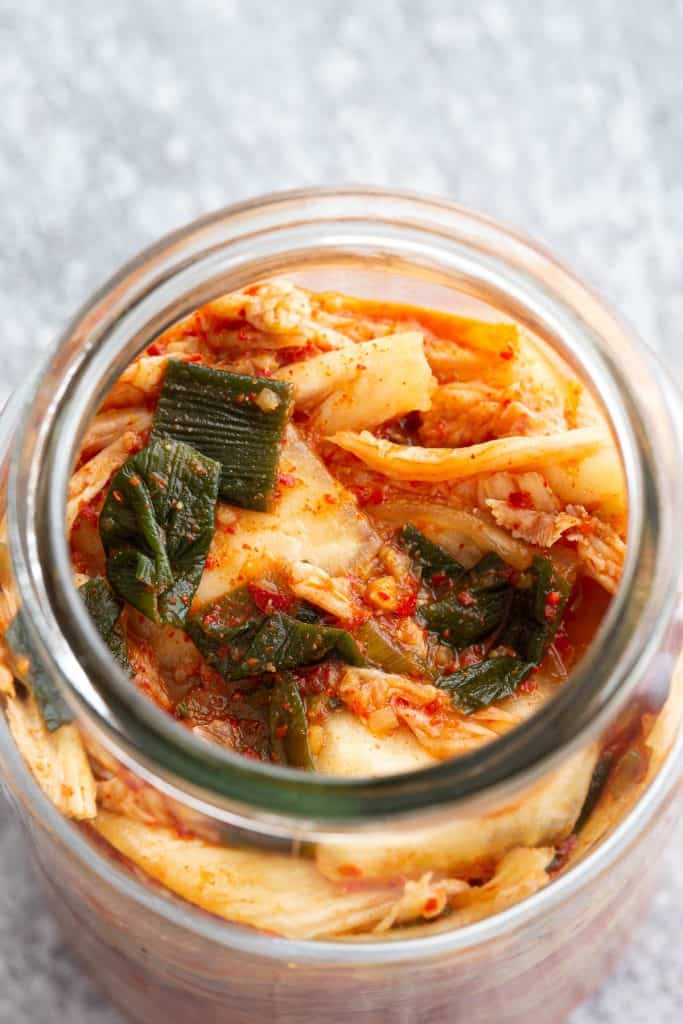
Try out these popular Korean dishes next:


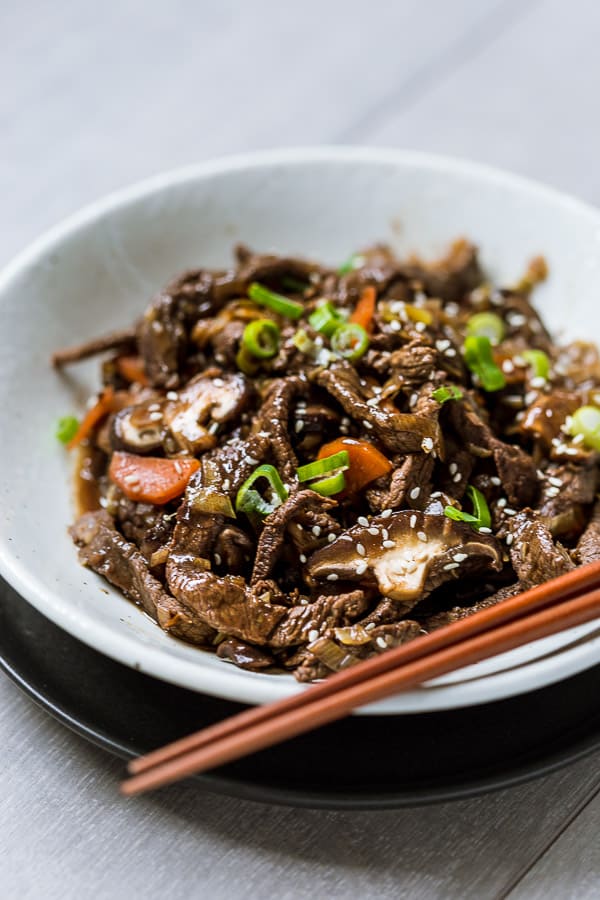

★ Did you make this recipe? Please leave a comment & star rating below!
Ingredients
- 1/4 cabbage napa
- 3 tbsp salt coarse or rock
- 6 cups water cold
- 2 tbsp Korean hot pepper flakes / gochugaru double or triple this amount for spice lovers
- 1 tbsp garlic
- 1 tbsp salted shrimp sub with miso paste or fish sauce
- 1 tbsp fish sauce Korean style
- 1 tbsp sugar
- 1 tbsp pear juice sub with apple juice
- 1/4 tsp dashi powder dissolved in 1 tbsp warm water
- 1 bunch spring onion / green onion chopped
Instructions
- Chop cabbage into large chunks and sprinkle with the salt. Mix it through all the leaves. Add 6 cups (1.5 quart / 1.5 litres) of cold water and mix the cabbage again. Pop a heavy plate on top, to keep the cabbage under water.1/4 cabbage, 3 tbsp salt, 6 cups water
- Soak the salted cabbage in the salt water for 4 – 6 hours, turning over the cabbage pieces every 2 hours. Humidity will play a role here, so the higher the humidity in your environment the less time you'll need to soak and vice versa. In Australia, it's recommended to soak around 4 hours.
- While the cabbage is soaking, it's time to mix the seasoning. In a small bowl, add the Korean chilli flakes, garlic, salted shrimp (or miso), fish sauce, sugar, pear juice (or apple), dashi powder dissolved in warm water and chopped spring onion.2 tbsp Korean hot pepper flakes / gochugaru, 1 tbsp garlic, 1 tbsp salted shrimp, 1 tbsp fish sauce, 1 tbsp sugar, 1 tbsp pear juice, 1/4 tsp dashi powder, 1 bunch spring onion / green onion
- After soaking the cabbage, rinse the cabbage two or three times under fresh water to remove the salt. We find a colander works well for this step. The cabbage should now have a flexible texture.
- Transfer the rinsed cabbage to a large bowl and add the kimchi seasoning. (We recommend gloves for this next step.) Using your hands, work the seasoning through the cabbage, making sure everything is very well coated. You can have a taste here and see if your kimchi needs any more chilli or salt to your preference.
- Next it’s time to store the kimchi in a large jar. We recommend lining the top of the jar with cling wrap, then poking a hole to fill it, that way the the top of the jar will stay clean. Pop in all the kimchi, then press it down firmly so it’s all compacted. This is important to get out air bubbles and help the fermentation process.
- Leave on the bench for 24 hours to kick off the fermentation, then transfer to the fridge and eat whenever you like.
Video
Recipe Notes
- Don’t Seal Tightly – Since kimchi is a fermented food, gasses can build as part of the fermentation process. It’s best not to seal the jar or container too tightly, otherwise it could potentially pop and overflow!
- Storage – Kimchi will last one week out of the fridge at room temperature, as the fermentation process is sped up. However, it will last 3-6 months in the fridge. If it has any mould, smells alcoholic or ‘off’, then it should be discarded straight away.
- Napa Cabbage – Also known as Baechu in Korean, or sometimes referred to as Chinese/ Asian cabbage or wombok. This is the traditional cabbage used for kimchi. It has the perfect texture of crunchy stems and soft leaves, and contains less water than other varieties for a better texture in Kimchi. You can substitute if necessary, but you’ll need to adjust your fermentation time to account for the difference in texture of other cabbage varieties.
- Coarse Salt (Sea Salt) – This is used to soak and soften the cabbage because it melts slower and so absorbs into the leaves more gradually. We don’t recommend using fine salt or regular table salt as this can affect the fermentation process.
- Korean Hot Pepper Flakes (Gochugaru) – These chilli flakes are milder than regular chilli flakes. The chillies are deseeded before processing, giving them the classic bright red colour. Substitute with Korean red pepper paste / gochujang in a pinch.
- Salted Shrimp – Substitute with miso paste (red in the first instance, or white), or with fish sauce. Otherwise, use soy sauce for the vegan version.
- Fish sauce (Korean style) – Substitute with soy sauce for the vegan variant.
- Pear juice – Substitute with apple juice.
- Dashi stock – Japanese or Korean dashi stock works. Substitute with 1/2 tsp fish sauce in a pinch.
- Add Carrots and Daikon – You can grate or julienne carrot and daikon to add to your kimchi for an extra flavour hit.
Nutrition


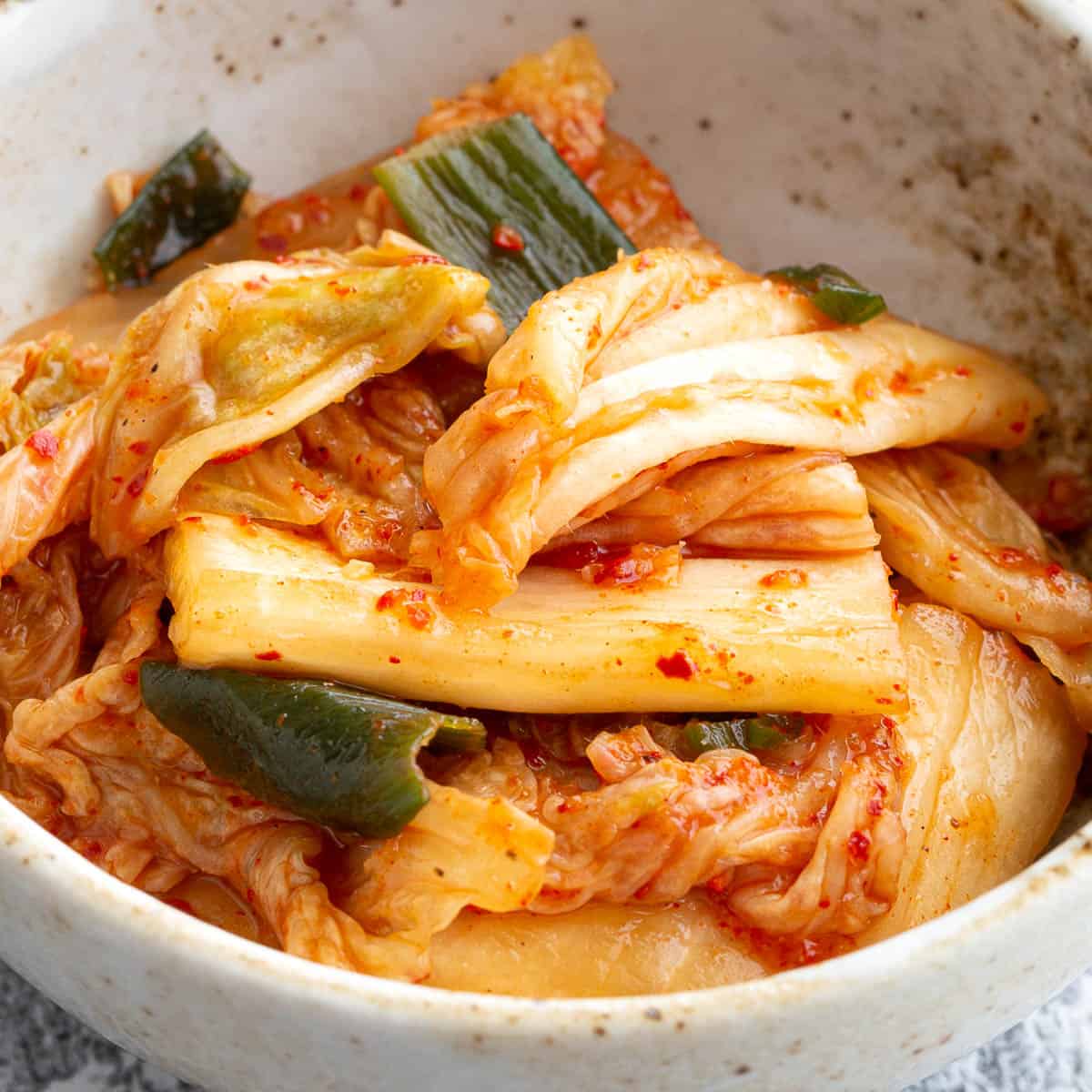



6 Comments
Sidney
07/11/2022 at 7:04 pmThis looks great, and really straightforward!
I am wondering – is it really just 1/4 of a head of Napa cabbage? About how many pounds would you say that is?
Wandercooks
08/11/2022 at 1:59 pmHey Sidney, we didn’t weigh the cabbage sorry, I will on our next batch though. However, I’d probably guess a quarter would be around half a pound? It’s a small batch of kimchi, so you can double or quadruple or the recipe for a half or whole cabbage. 🙂
Stephanie Soon
24/04/2021 at 2:14 pmThis recipe looks simple, shall go buy all the ingredients and give it a go. Thank you 😊
Wandercooks
27/04/2021 at 10:51 amYou’re welcome Stephanie! Have fun popping it together and let us know how you go!
Adeline Lee
29/10/2019 at 9:44 amThis receipe looks simple and easy to follow. But I have one question. May I ask Korean seaweed and fish stock is it store bought ?
Wandercooks
07/11/2019 at 12:21 pmHi Adeline, when we originally made this recipe we used real stock made from seaweed and pollack (fish). But at home, we substitute with dried seaweed stock such as dashi. It saves time and is very convenient. 🙂